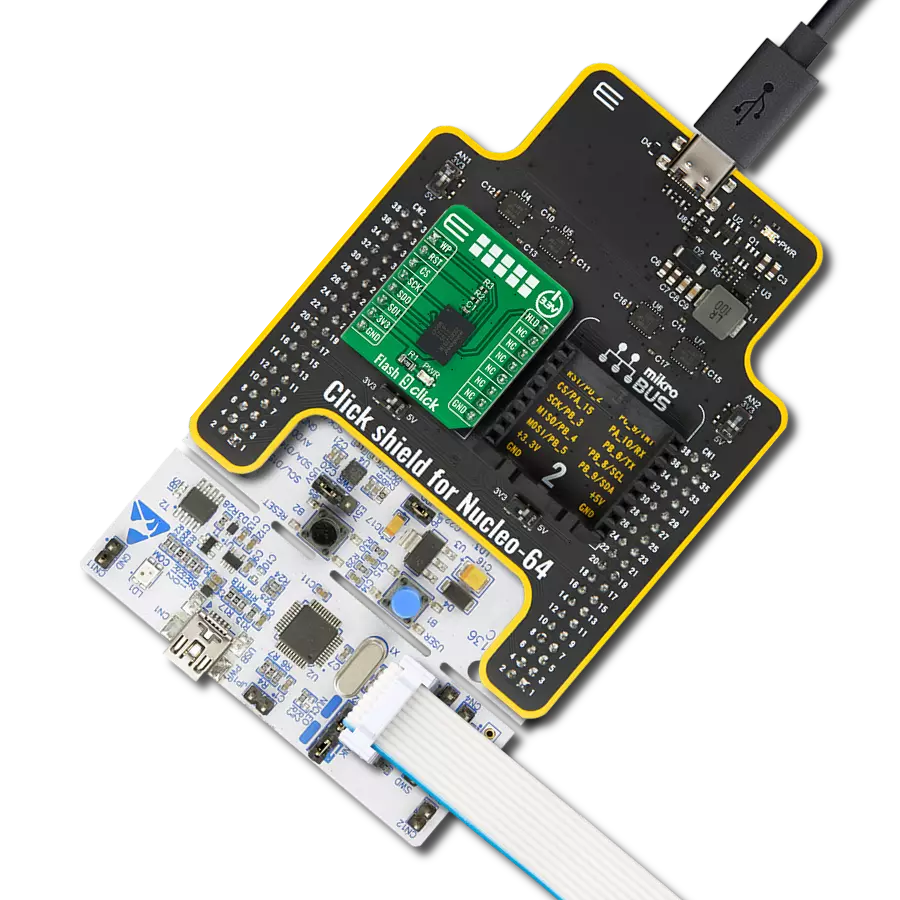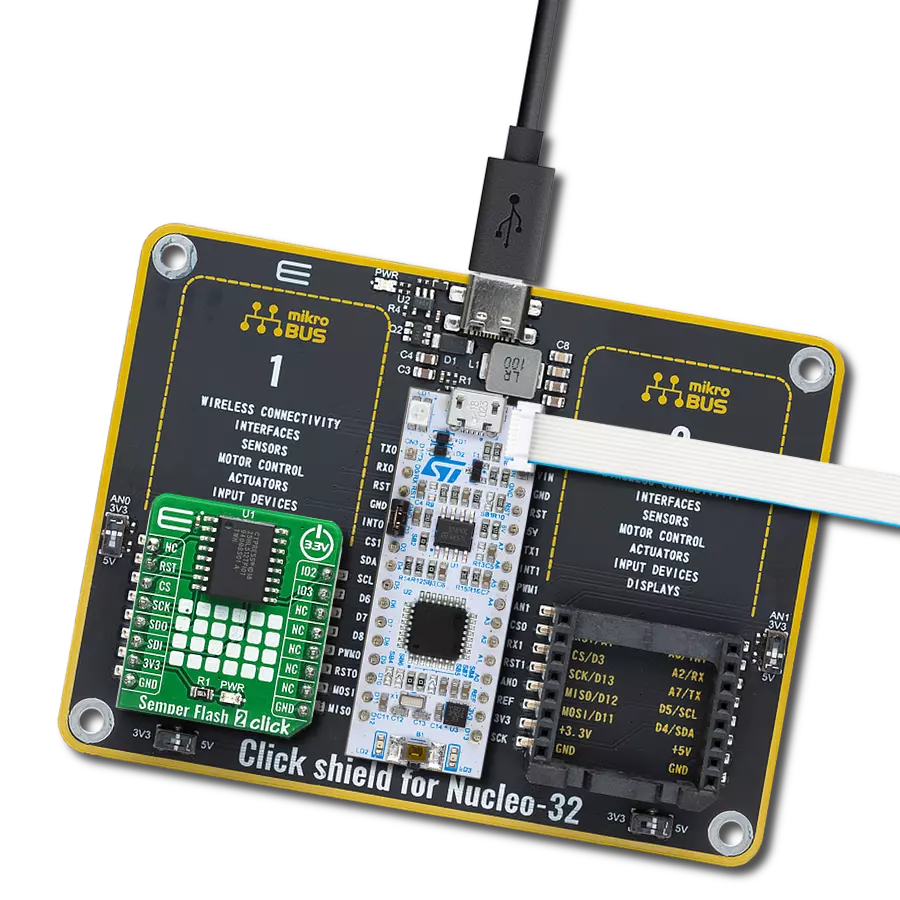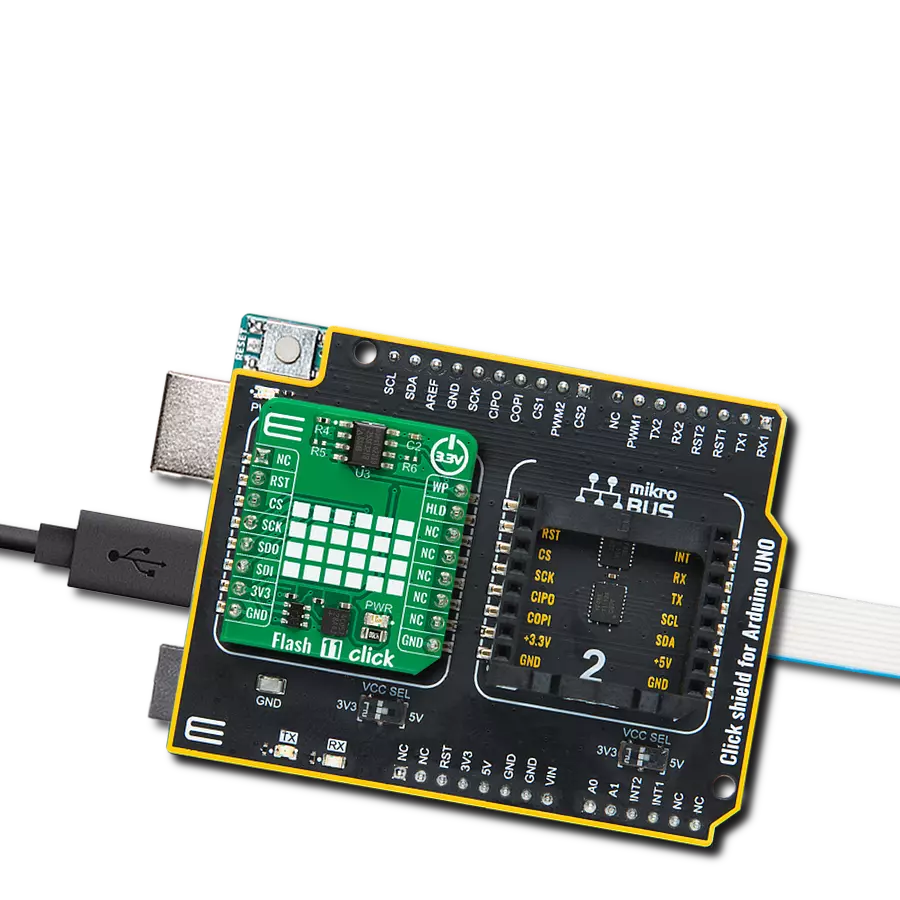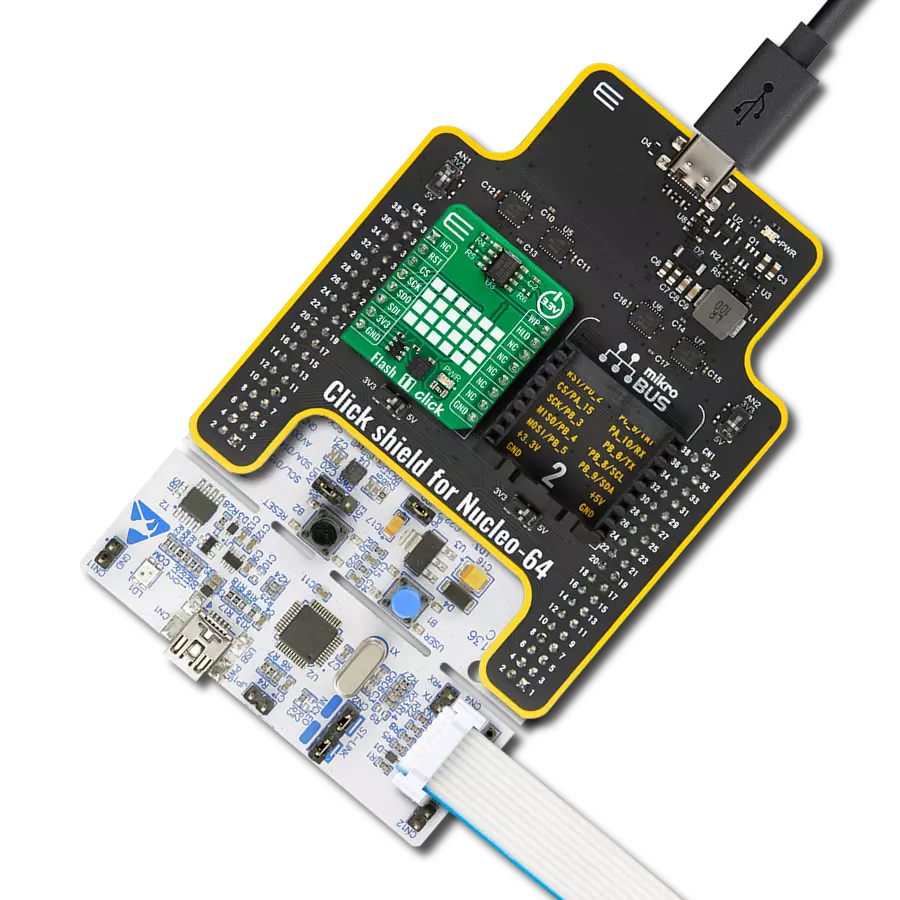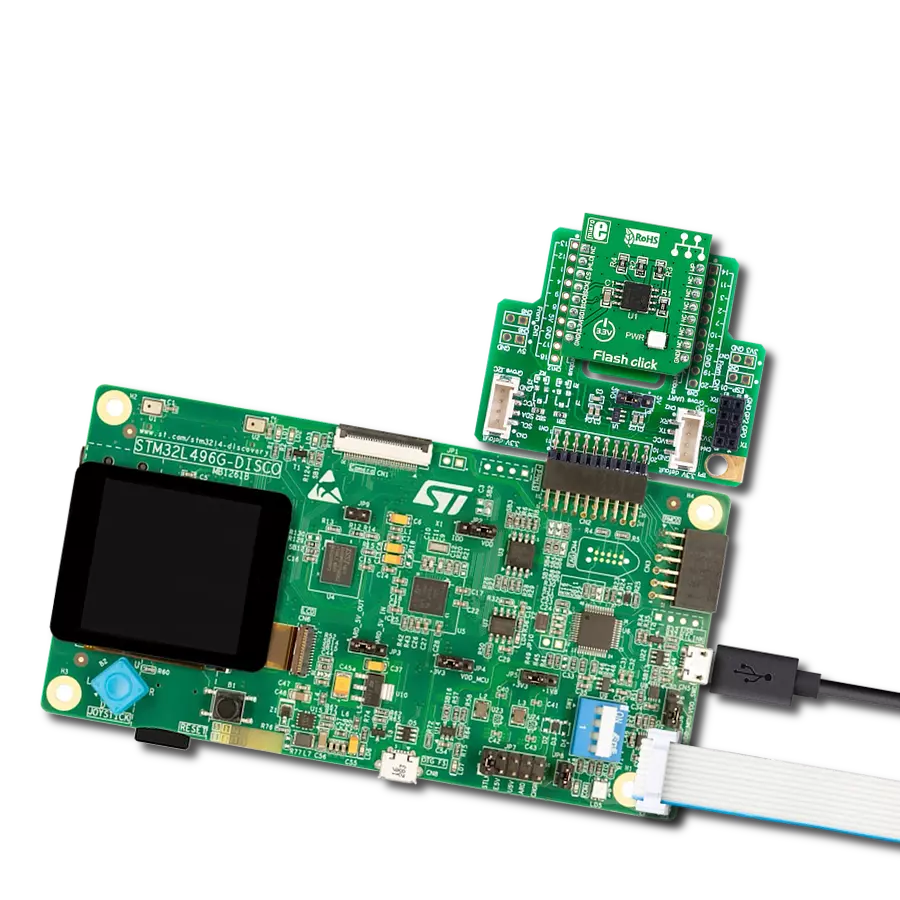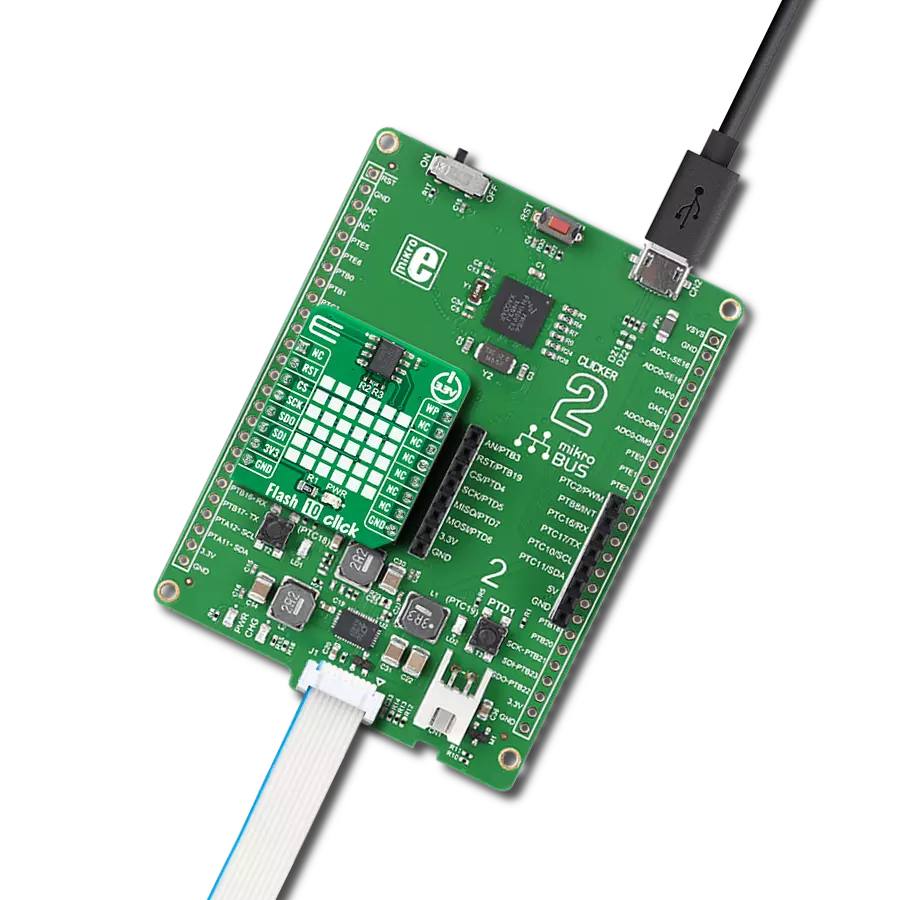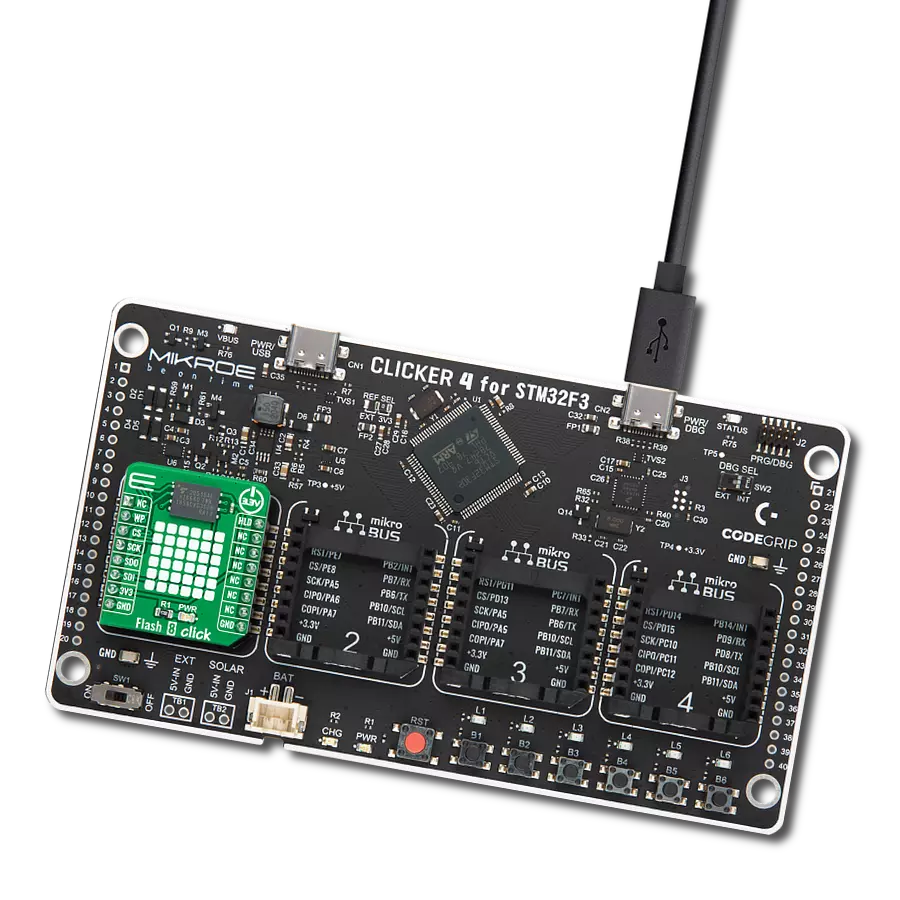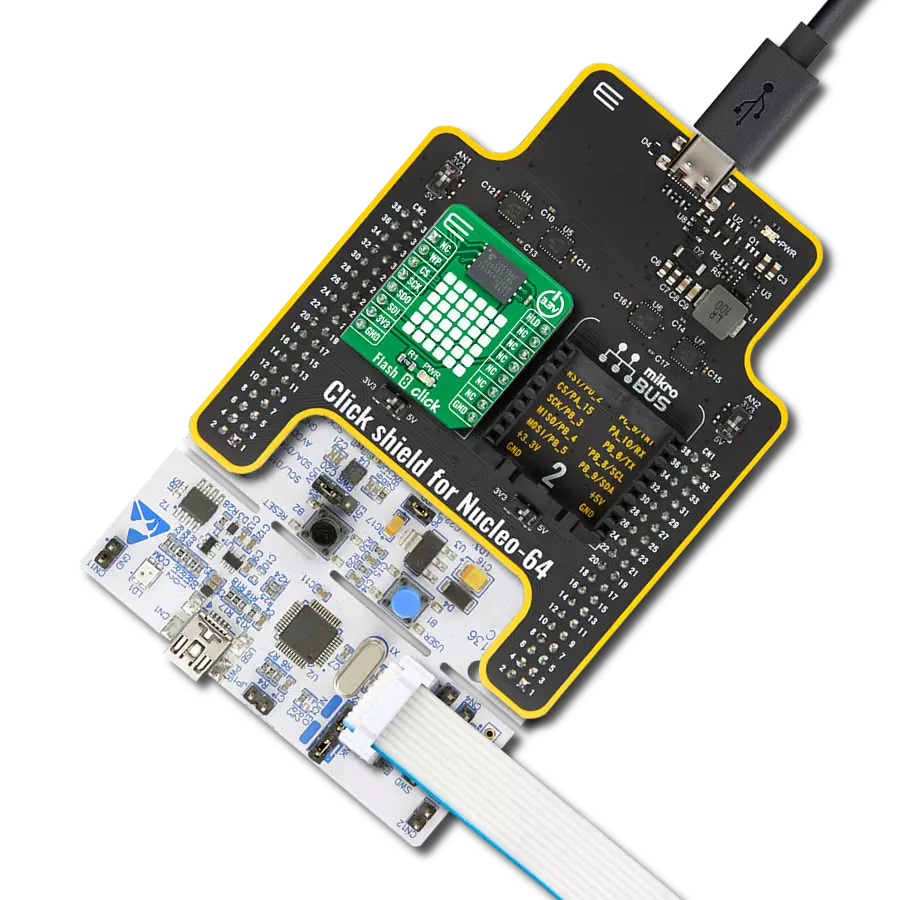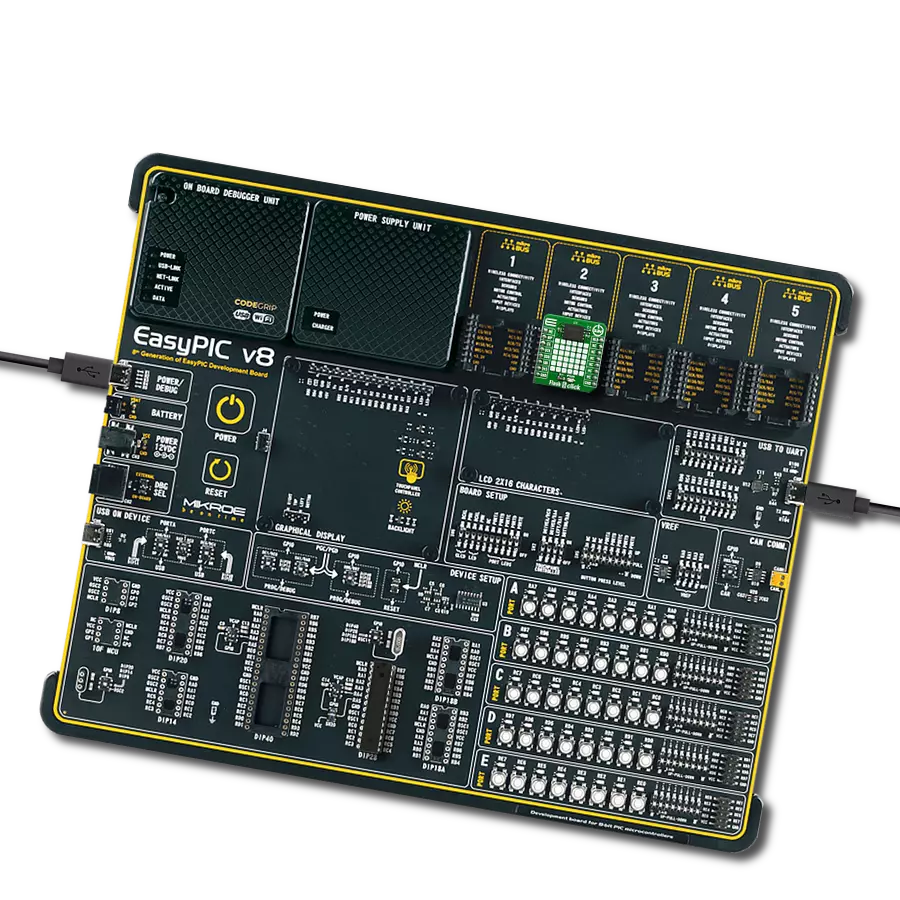Experience the power of multiple protocols, including Dual I/O, Quad I/O (QIO), and Quad Peripheral Interface (QPI), offered by our Semper Flash solution for flexible connectivity
A
A
Hardware Overview
How does it work?
Semper Flash Click is based on the S25HS512T, a 512 Mbit SPI Flash memory module from Infineon. Featuring both normal and double data rates over the standard, Dual/Quad SPI interface, the improved reliability of the stored information by utilizing the hardware Error Correction Code (ECC) generation, One-Time Programmable (OTP) memory block of 1024 bytes, advanced sector protection, AutoBoot, and much more, this Click board™ is a perfect solution for the mass storage option in various embedded applications. Due to its fast performance, Semper Flash click can also be used for code shadowing, execute-in-place (XIP), data logging, and data storage. An additional level translator IC allows Semper Flash click to be used with a wide range of MCUs. The device control logic is subdivided into two parallel operating sections: the Host Interface Controller (HIC) and the Embedded Algorithm Controller (EAC). The HIC monitors signal levels on the device inputs and drives outputs to complete read, program and write data transfers with the host system. The HIC delivers data from the currently entered address map on read transfers, places write transfer address and data information into the EAC command memory and notifies the EAC of power transition and write transfers. The EAC interrogates the command memory after a program or writes transfer for legal command sequences and performs the related Embedded Algorithms. Executing code directly from Flash
memory is often called Execute-In-Place (XIP). By using XIP with Semper Flash devices at the higher clock rates with Quad or DDR Quad SPI transactions, the data transfer rate can match or exceed traditional parallel or asynchronous NOR flash memories while reducing signal count dramatically. The advanced MirrorBit® technology allows storing two data bits in each memory array transistor (memory cell), effectively doubling the capacity of a single storage cell. The Eclipse™ architecture is responsible for the greatly improved erase and programming performance, compared to other Flash modules of the previous generation. Due to a higher speed, an execute-in-place (XIP) and data shadowing is possible with the Semper Flash click. One of the S25HS512 T's key features is the AutoBoot feature. It allows the module to automatically initiate the memory transfer from the predefined location (memory read operation) after the reset cycle. Considering a typical communication scenario, where the READ command followed by one or more address bytes need to be used, AutoBoot allows the host MCU to pull down the #CS (Chip Select) pin and start receiving a data stream over the SPI interface for as long as the #CS pin is held LOW, without any wasted cycles. When the #CS pin is released, the S25HS512T returns to normal operation. Advanced Sector Protection (ASP) is a powerful protection model incorporating various software and hardware methods to turn programming on or off
or erase operations within a sector or an entire memory. A specialized ASP OTP register offers password protection or a persistent protection mode, allowing increased flexibility in the protection. Using the OTP memory allows the protection mode to remain in place for the whole life-cycle of the device. The SPI interface pins are routed to the mikroBUS™ so that the interfacing with the microcontroller unit (MCU) is easy and straightforward. Additional pins routed to the mikroBUS™ include the #WP/IO2 pin routed to the mikroBUS™ PWM pin and labeled as IO2 and the #HOLD/IO3 pin routed to the mikroBUS™ INT pin and labeled as IO3. There is also the RESET pin, routed to the RST pin of the mikroBUS™, which performs a reset of the Flash module, initiating an AutoBoot sequence if enabled. EnduraFlex Architecture allows system designers to customize the NOR Flash endurance and retention for their specific applications. The host defines partitions for high endurance or long retention, providing up to 1+ million cycles or 25 years of data retention. Data Integrity Check transactions in Semper Flash perform a hardware-accelerated Cyclic Redundancy Check (CRC) calculation over a user-defined address range in the memory array. The SafeBoot feature allows Status Register polling to detect an embedded microcontroller initialization failure or configuration register corruption through error signatures.
Features overview
Development board
Nucleo-64 with STM32F091RC MCU offers a cost-effective and adaptable platform for developers to explore new ideas and prototype their designs. This board harnesses the versatility of the STM32 microcontroller, enabling users to select the optimal balance of performance and power consumption for their projects. It accommodates the STM32 microcontroller in the LQFP64 package and includes essential components such as a user LED, which doubles as an ARDUINO® signal, alongside user and reset push-buttons, and a 32.768kHz crystal oscillator for precise timing operations. Designed with expansion and flexibility in mind, the Nucleo-64 board features an ARDUINO® Uno V3 expansion connector and ST morpho extension pin
headers, granting complete access to the STM32's I/Os for comprehensive project integration. Power supply options are adaptable, supporting ST-LINK USB VBUS or external power sources, ensuring adaptability in various development environments. The board also has an on-board ST-LINK debugger/programmer with USB re-enumeration capability, simplifying the programming and debugging process. Moreover, the board is designed to simplify advanced development with its external SMPS for efficient Vcore logic supply, support for USB Device full speed or USB SNK/UFP full speed, and built-in cryptographic features, enhancing both the power efficiency and security of projects. Additional connectivity is
provided through dedicated connectors for external SMPS experimentation, a USB connector for the ST-LINK, and a MIPI® debug connector, expanding the possibilities for hardware interfacing and experimentation. Developers will find extensive support through comprehensive free software libraries and examples, courtesy of the STM32Cube MCU Package. This, combined with compatibility with a wide array of Integrated Development Environments (IDEs), including IAR Embedded Workbench®, MDK-ARM, and STM32CubeIDE, ensures a smooth and efficient development experience, allowing users to fully leverage the capabilities of the Nucleo-64 board in their projects.
Microcontroller Overview
MCU Card / MCU
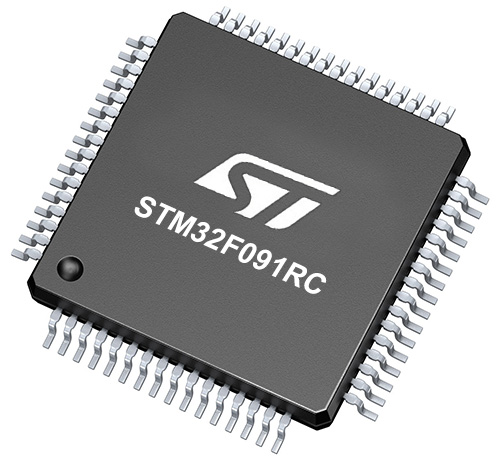
Architecture
ARM Cortex-M0
MCU Memory (KB)
256
Silicon Vendor
STMicroelectronics
Pin count
64
RAM (Bytes)
32768
You complete me!
Accessories
Click Shield for Nucleo-64 comes equipped with two proprietary mikroBUS™ sockets, allowing all the Click board™ devices to be interfaced with the STM32 Nucleo-64 board with no effort. This way, Mikroe allows its users to add any functionality from our ever-growing range of Click boards™, such as WiFi, GSM, GPS, Bluetooth, ZigBee, environmental sensors, LEDs, speech recognition, motor control, movement sensors, and many more. More than 1537 Click boards™, which can be stacked and integrated, are at your disposal. The STM32 Nucleo-64 boards are based on the microcontrollers in 64-pin packages, a 32-bit MCU with an ARM Cortex M4 processor operating at 84MHz, 512Kb Flash, and 96KB SRAM, divided into two regions where the top section represents the ST-Link/V2 debugger and programmer while the bottom section of the board is an actual development board. These boards are controlled and powered conveniently through a USB connection to program and efficiently debug the Nucleo-64 board out of the box, with an additional USB cable connected to the USB mini port on the board. Most of the STM32 microcontroller pins are brought to the IO pins on the left and right edge of the board, which are then connected to two existing mikroBUS™ sockets. This Click Shield also has several switches that perform functions such as selecting the logic levels of analog signals on mikroBUS™ sockets and selecting logic voltage levels of the mikroBUS™ sockets themselves. Besides, the user is offered the possibility of using any Click board™ with the help of existing bidirectional level-shifting voltage translators, regardless of whether the Click board™ operates at a 3.3V or 5V logic voltage level. Once you connect the STM32 Nucleo-64 board with our Click Shield for Nucleo-64, you can access hundreds of Click boards™, working with 3.3V or 5V logic voltage levels.
Used MCU Pins
mikroBUS™ mapper
Take a closer look
Click board™ Schematic

Step by step
Project assembly
Software Support
Library Description
This library contains API for Semper Flash Click driver.
Key functions:
semperflash_write_memory- This function writes data to the flash memorysemperflash_read_memory- This function reads data from the flash memorysemperflash_erase_memory- This function erases data from the flash memory
Open Source
Code example
The complete application code and a ready-to-use project are available through the NECTO Studio Package Manager for direct installation in the NECTO Studio. The application code can also be found on the MIKROE GitHub account.
/*!
* \file
* \brief SemperFlash Click example
*
* # Description
* This example showcases how to initialize and use the Semper Flash Click. The Click
* is a 512 Mbit SPI Flash memory module. Data can be stored in and read from the flash
* memory. There's also the option of erasing it's contents. Here's how to do it.
*
* The demo application is composed of two sections :
*
* ## Application Init
* This function initializes and configures the Click and logger modules. Additional con-
* figuring is done in the default_cfg(...) function. The device ID should appear in the
* UART console if the setup finishes successfully.
*
* ## Application Task
* This function first erases the contents of the flash memory and then writes, reads and
* prints two strings in the UART console. It does so every 2 seconds.
*
* \author MikroE Team
*
*/
// ------------------------------------------------------------------- INCLUDES
#include "board.h"
#include "log.h"
#include "semperflash.h"
// ------------------------------------------------------------------ VARIABLES
static semperflash_t semperflash;
static log_t logger;
uint8_t id_data[ 8 ];
uint8_t txt_flag;
uint8_t COMPANY_FLAG = 2;
uint8_t CLICK_FLAG = 3;
uint32_t ADRESS_MEMORY = 0x00001111;
// ------------------------------------------------------- ADDITIONAL FUNCTIONS
void error_handler ( uint8_t stat )
{
if ( SEMPERFLASH_ID_ERROR == stat )
{
log_printf( &logger, "ID ERROR!" );
for ( ; ; );
}
else if ( SEMPERFLASH_SIZE_ERROR == stat )
{
log_printf( &logger, "BUF SIZE ERROR!" );
for ( ; ; );
}
}
void id_check ( )
{
uint8_t cnt;
error_handler( semperflash_check_manufacturer_id( &semperflash ) );
error_handler( semperflash_get_device_id( &semperflash, id_data ) );
log_printf( &logger, "DEVICE ID: 0x" );
for ( cnt = 0; cnt < SEMPERFLASH_DEVICE_ID_BYTE_SIZE; cnt++ )
{
log_printf( &logger, "%x", ( uint16_t )id_data[ cnt ] );
}
log_printf( &logger, "\r\n\r\n" );
txt_flag = COMPANY_FLAG;
}
// ------------------------------------------------------ APPLICATION FUNCTIONS
void application_init ( )
{
log_cfg_t log_cfg;
semperflash_cfg_t cfg;
/**
* Logger initialization.
* Default baud rate: 115200
* Default log level: LOG_LEVEL_DEBUG
* @note If USB_UART_RX and USB_UART_TX
* are defined as HAL_PIN_NC, you will
* need to define them manually for log to work.
* See @b LOG_MAP_USB_UART macro definition for detailed explanation.
*/
LOG_MAP_USB_UART( log_cfg );
log_init( &logger, &log_cfg );
log_info( &logger, "---- Application Init ----" );
Delay_ms ( 100 );
// Click initialization.
semperflash_cfg_setup( &cfg );
SEMPERFLASH_MAP_MIKROBUS( cfg, MIKROBUS_1 );
semperflash_init( &semperflash, &cfg );
semperflash_default_cfg( &semperflash );
id_check( );
Delay_ms ( 500 );
}
void application_task ( )
{
char write_data_com[ 7 ] = "MikroE";
char write_data_clk[ 13 ] = "Semper Flash";
char read_buf_data[ 13 ] = { 0 };
semperflash_send_cmd( &semperflash, SEMPERFLASH_WRITE_ENABLE );
semperflash_erase_memory( &semperflash, ADRESS_MEMORY );
if ( COMPANY_FLAG == txt_flag )
{
semperflash_send_cmd( &semperflash, SEMPERFLASH_WRITE_ENABLE );
error_handler( semperflash_write_memory( &semperflash, ADRESS_MEMORY, write_data_com, 6 ) );
error_handler( semperflash_read_memory( &semperflash, ADRESS_MEMORY, read_buf_data, 6 ) );
log_printf( &logger, "%s\r\n", read_buf_data );
txt_flag = CLICK_FLAG;
}
else if ( CLICK_FLAG == txt_flag )
{
semperflash_send_cmd( &semperflash, SEMPERFLASH_WRITE_ENABLE );
error_handler( semperflash_write_memory( &semperflash, ADRESS_MEMORY, write_data_clk, 12 ) );
error_handler( semperflash_read_memory( &semperflash, ADRESS_MEMORY, read_buf_data, 12 ) );
log_printf( &logger, "%s\r\n", read_buf_data );
txt_flag = COMPANY_FLAG;
}
log_printf( &logger, "....................\r\n" );
Delay_ms ( 1000 );
Delay_ms ( 1000 );
}
int main ( void )
{
/* Do not remove this line or clock might not be set correctly. */
#ifdef PREINIT_SUPPORTED
preinit();
#endif
application_init( );
for ( ; ; )
{
application_task( );
}
return 0;
}
// ------------------------------------------------------------------------ END
Additional Support
Resources
Category:FLASH





















